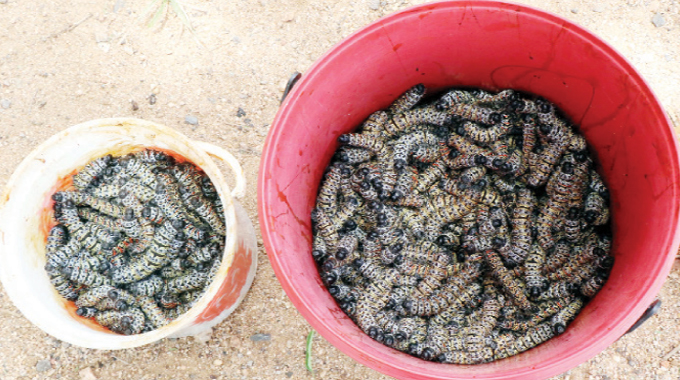Harvesting mopane worms: Down memory lane, Part 1

Pathisa Nyathi
SOON after driving past Maphisa we were met with bare and forlorn mopane trees. An engaging gaze revealed emerging artistic landscape fraught with hordes of wriggling and crawling mopane worms at different stages of development.
The majority of them are moving in desperation, searching for trees with leaves. A fruitless search ends in death. The road is littered with mopane worms that have been trampled lifeless by cars and scotch carts plying the dirt road to Sun Yet Sen.
It is mopane worm season. Mahonja! Mahonja! A bird whose call is soothing and welcome never fails to alert the villagers about the bountiful season. Whenever we heard the call, we knew the crunchy worms would soon make some appearance, twice a year.
The first crop appears in December about Christmas time. The second batch arrives in April. Mahonja is a Kalanga word for what the Ndebele call amacimbi, mopane worms. Other worms feed on mopane leaves. One is called ipipi. It is green and slightly bigger than a mopane worm.
These are generally found in smaller numbers in comparison to the plentiful and voracious mopane worms. Some people eat these but we do not.
In addition, there are worms that quietly stay camouflaged on mopane tree stems. They are hairy and when grown up, they form silk cocoons. It is these that are harvested and used to make leg rattles, amahlwayi, that dances of woso (amabhiza) and wosana use.
We call this scary worm ibhayiletshumi. Some time back there used to be a cheap blanket (ibhayi) of the same colour as this worm and was bought at the selling price of ten dollars (itshumi), hence the name ibhayiletshumi for the worm and the blanket.
Mopane worms are easy money and villagers of Maphaneni will temporarily abandon agricultural chores and household tasks to harvest amacimbi which have found their way into supermarkets and other markets where they have been packaged after drying them.
For relish-starved villagers amacimbi are a delicious alternative to umfushwa. Villagers in this part of the world have developed the art of cooking the worms. Unlike what goes on in urban restaurants, our mothers fried them dry and added milk cream, ulaza. It was a finger-licking experience.
Not so in the cities where the chefs add tomatoes and sometimes even onions and serve the worms soft. That was not our culinary tradition.
I felt some sense of guilt when I drove over the hordes of desperation. Below the naked trees were visible brown droppings of the worms that have taken the shape of hand grenades. Here and there, you see the ubiquitous Honda Fit cars that are out to buy the lucrative commercial commodity that fetches good prices especially beyond Matabeleland. Mopane worms are regarded as a delicacy and tickle many a tongue.
Their taste is irresistible. Barter trade goes on here. Commercial entrepreneurs bring items of clothing, sugar, soap, and flour, among numerous other commodities to exchange for amacimbi.
Many cars take harvesters who camp out in the bush. As a result, harvesting is no longer sustainable. When we grew up, we knew the stage when it was regarded as ideal to harvest the worms. While we did sell some of the mopane worms, emphasis was on household consumption.
Those who harvest to sell do not care even if the worms are immature. Their products are sold in towns and cooked the town way. Some of the harvesters will use axes to cut down mopane tree branches so that they access the worms that are high.
Considerations for sustainable harvesting are thrown overboard. The process of disemboweling, ukukhama is never thorough. Who cares, the fellows will not consume the poorly processed worms after all. For them money in the pocket that counts.
I heard of cases where some harvesters sever the heads of the worms and force the entrails through the open neck. These people fear the worms especially when they twist and wriggle in self-defence. New traditions regarding harvesting are developing, mostly driven by an irresponsible and carefree attitude.
It was not so some years back when locals alone carried out the harvesting process. Responsible and sustainable forms of harvesting were the norm.
The harvesters knew that in order to have more worms the next time there had to be worms that reached the stage of maturity.
Mature worms stop feeding and clean their insides in readiness for the trip down the trees. We called these worms isumbe. They burrow into the ground where in silence they transform into pupae.
Pupae emerged out of the ground at the time when the bird made the call-Mahonja! Mahonja! Out comes a beautiful butterfly, brown in colour with large velvety circular spots on each dorsal side of the wing. The appearance is calculated to deceive would-be predators.
The two large spots look like a pair of eyes of a huge and ferocious animal. Predators dare not move anywhere nearby. Deceived.
The majestic butterflies lay clusters of small white eggs on the top side of leaves. When it is a bad year, birds prey on the eggs and reduce the population of worms. From a dark hue, hatched hairy worms eat the hosting leaf and begin moving to other leaves and, in no time the leaves disappear into the tubular stomachs of the voracious eaters.
When it is a year when the worms are scarce, people cut off braches with eggs and place them on trees near their homes. They know that no one will venture too close and harvest near a homestead that is not their own. The sense of territoriality is expressed in numerous ways among the rural folk.
However, when the worms are plentiful there is no need to resort to this method. Still, villagers give priority to the worms closest to their own homes. Far from the homes it is territory open to any one where they are free to harvest.
There is some ca ca ca sound as worms consume the leaves. When temperatures are high, the worms lower their anterior ends and stop feeding. Otherwise, the little caterpillars eat continuously and gain weight over a very short period. When there is moisture on the leaves, the worms grow even faster.
When one walks below the trees with worms, the creatures have their own defensive mechanism. Through the mouth a worm secrets some brown-coloured juice which does not readily wash off. Harvesters dress like scarecrows. Every day they wear the same clothes that, by the end of the harvest season, will be thrown away. Good for nothing.
The spikes on the dorsal side of the worm damage their hands. When the insect wriggles and writhes the spikes act like short assegais and make holes into the skin. The brown juice goes into the holes and the brown colouring lasts. The process is like tattooing, albeit without some chosen pattern.
Those who wish to protect their hands use hand gloves. Sometimes the hands develop puss-filled wounds. It is for this reason that uncharacteristic methods of disemboweling are resorted to. My father used bicycle tube that he cut up and fashioned into thimbles that he used to cover the tips of his fingers.
In Part II we shall deal with my experiences when I too took part in the process of harvesting. It was great fun and time to reminisce with the past.











Comments